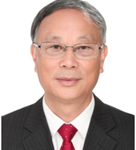
Professor Xinping Yan
Title: Developments and Applications of Intelligent Control Technology for Inland Waterborne Transportation in China
Bio:
Dr. Xinping Yan is Chair Professor and Director of National Engineering Research Center for Water Transport Safety (MoST), Base for International Science & Technology Cooperation on Smart Shipping and Maritime Safety (MoST), Wuhan University of Technology, China. He is the chair of Intelligent Water Transport Safety of IEEE ITS and a Fellow and Chartered Marine Scientist of IMarEST. In 2019, He was elected Academician of the Chinese Academy of Engineering (CAE). His research interests include intelligent transport system key technologies, intelligent fault diagnosis of marine engines, renewable energy, energy efficiency management of the vessel, navigation systems for vessels, etc.
Abstract:
Intelligent Waterborne Transportation is blooming with the new era of intelligent and green vessels for more efficient logistics. Intelligent control technology is the key to securing reliability and efficiency for autonomous functions. An overview of developments in ship control is given including mathematical modeling, planning strategies, control algorithms, etc. Accordingly, the concept and construction of Navigation Brain System (NBS) is introduced as a compact solution for intelligent ships. Furthermore, the applications of NBS to autonomous and remote-controlled inland vessels for future new generation of inland waterborne transportation system. In the end, engineering experience from applications and suggestions for the future are concluded.
 Professor Kai Cheng
Professor Kai Cheng
Title: Ultraprecision design and manufacturing of freeform surfaced ‘sensor’ devices and components: fundamentals, applied research, and industrial applications
Bio:
Professor Kai Cheng is a Chair Professor in Manufacturing Systems at Brunel University London. His current research interests focus on design of high precision machines, ultraprecision and micro/nano manufacturing, in-process monitoring and metrology, smart tooling and smart machining. He is currently leading the Ultraprecision and Micro/Nano Manufacturing Theme at Brunel University London, which involves 15 academic staff, and about 50 PhD students and researchers. Professor Cheng and his team have enjoyed working closely with industrial companies internationally. They are working on a number of research projects funded by the EPSRC, NATEP Program, RAEng, Innovate UK program, EU Horizon 2020 Programs, and the industry. Professor Cheng is a Charted Engineer and a Fellow of the IMechE and IET, the European editor for International Journal of Advanced Manufacturing Technology, and also honored as the visiting professor at Harbin Institute of Technology.
Abstract:
In this presentation, it firstly provides a critical review on the fundamentals and key enabling technologies for ultraprecision design and manufacturing of freeform surfaced sensor devices and components, particularly based on the first-hand experience in addressing current industrial R&D needs for automotive head-up displays (HUDs), ophthalmic vari-focal lenses, and TMA (three mirror anastigmat) mirrors for space optics purposes. They are well applied as ‘sensors’ and/or ‘sensor systems’ in the emerging high-tech industries and applications. Secondly, it discusses and explores the NURBS (Non-uniform rational B-spline) based modelling and analysis for freeform surfaces and their full integration with ‘sensor’ product design, ultraprecision manufacturing, metrology and functional assessment. Furthermore, application exemplars are also be presented and discussed with in-depth details against these three applications above, i.e. HUD devices, TMA mirrors, and in particularly, the varifocal lenses. The ultraprecision design and manufacturing of the vari-focal lens cover ophthalmic testing, surface modelling and analysis, freeform surfaced 3D model and digital device, CAD/CAM and toolpath generation, ultraprecision machining/3D printing, Ray tracing and function assessment, the process tracing/tracking and quality assurance. Finally, the presentation concludes with a further discussion on a proposed approach to moving forward the R&D in ultraprecision technology likely for the broader precision engineering applications.

